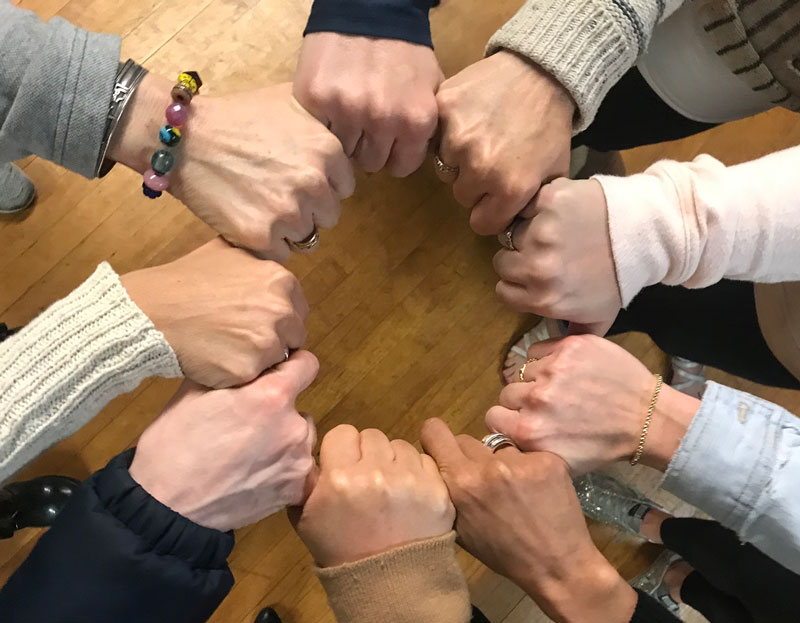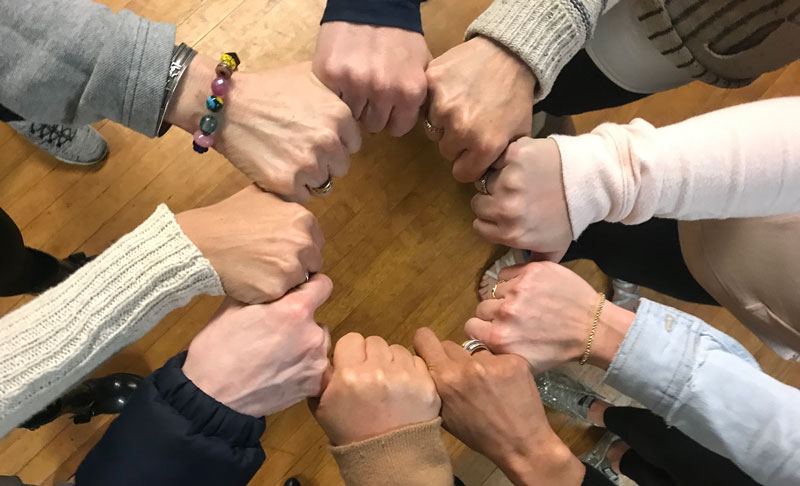
Life is too short to listen to mel robbins
There’s been a lot of buzz about an op-ed published in the New York Times right before Thanksgiving entitled, Life is Too Short…
...
Psychodrama – from the Greek – translates to the “soul in action.”
The creator of psychodrama, Jacob Levy Moreno was a real lover of the theater, and realized, “If I’m so moved; if I’m having such a catharsis by watching other people’s stories, what would it be like if we told our own stories?” That is what we do in psychodrama – we tell our stories – with witnesses – in action.
So let’s break that down into nuts and bolts. Psychodrama is a three-part modality, warm-up, action, and sharing.
We use action-based exercises to build connection, lower anxiety, and warm a group up to themes that are emerging amongst them, such as trauma, grief, or even how to stay present to joy.
This will lead to a few people in the group becoming warmed up enough – meaning, they’re have a desire to explore something in greater depth. Those people name what their psychodrama would be about, and then the group chooses which psychodrama to do that day. It’s important to note that the group is choosing a psychodrama, not a person, so it’s not a popularity contest – it’s the issue that the group members feel most connected to that day.
Then the protagonist – the person whose psychodrama we’ll be doing – and the director – that’s what we call the person who’s facilitating the psychodrama – then agree on a goal – or what we call a contract – and then we move into action by using role players – or what we call auxiliaries – to play out the issue the protagonist wants to explore. The protagonist can re-create scenes from their life that need repairing, or they can explore a future scene that they might want to practice, or sometimes both.
We use a variety of psychodrama techniques to help the protagonist experience interactions. Those could be with people in their lives, whether they’re still alive or or not. Those can be with parts of self or even with fictional characters or divine beings. That way, they get to complete things they didn’t get to do or say in real life – for example, saying goodbye to a loved one with whom they never got closure – and as a result, feel a greater sense of calmness or completion in their body and their mind.
Some people think you have to be an actor to participate in psychodrama, but ALL of it is unscripted, and it all comes from the protagonist. The director’s job is to follow – not lead them – to help reach their goal. As director, I’m not trying to impose my agenda on the protagonist – I’m not trying to get them somewhere, or to say or do something. We rely on what Moreno called the autonomous healing center of the protagonist – the belief that all the answers come from inside them – and know that the group and I are there to help them find them.
At the end of the psychodrama, we de-role the auxiliaries. That is, we have them step out of the roles that they’ve been playing by saying something like, “I’m no longer your mother, my name is Jane.” Then everyone in the group who played a role gets to share from that role. For example, Jane might share, “As your mother, I felt sad…” and then expand on why. Then, to further help her get out of the role, Jane would share how she identifies personally with the protagonist. For example, “I know that some of my actions led my own mother to feel hurt…” and then further share.
Regardless of whether they played a role or not, everyone in the group is invited to share with the protagonist how they identify. This is an integral part of psychodrama. We do NOT give advice or suggestions or analyze: we share directly with the protagonist how we identify with them, and with the work that they’ve done that day.
Because revealing so much about yourself as protagonist can be vulnerable, and has a potential to bring up shame, when the group shares back with the protagonist how they relate, the protagonist has the sense they’re not alone, and that other people not only understand, but identify. Sharing also has the added benefit of having the group members reveal more about themselves, which helps the group become more cohesive because everyone has an equal level of vulnerability.
After a warm up, the group chose a psychodrama about being afraid to ask for what you need. The protagonist – who we’ll call Jackie – was struggling with how to ask for a raise at work.
She had been working for an organization for about eight months, but despite being promised when she was hired that she would get a raise in six months if her work was good, her boss hadn’t scheduled a review. She was really scared to ask to meet with him, because she didn’t want to “bother him,” or “ruffle feathers.”
Jackie and I set a contract of her being able to successfully ask her boss for a raise, despite her fear. So I invited her to set a scene where she would have this conversation with her boss. She used some chairs in the room and some props and set up the scene of his office, and then I asked her to choose fellow group members to play the roles of the necessary people in this drama, and/or parts of herself.
So she chose someone to play her boss, and that person came and sat in the scene for a moment, while she chose the other role players – or what we call auxiliaries. I invited her to choose someone to play the role of a resource – which is always a good idea in a psychodrama about fear – so she close someone to play her confident self, and that person came and sat in the scene for now. When I asked her if anyone else needed to be in the scene, she chose someone to play her scared part.
We started by moving into what we call role training, that is, the protagonist has to teach the people who play the role how to play their roles. So I first had her role reverse with her boss – that is she physically changed places with the person in the role of the boss, and the person who playing her boss came over and stood where Jackie had been standing.
I then interviewed Jackie in the role of her boss, so the person playing the role would know how to do it. I asked her some questions as boss such as, “Tell me how Jackie has been doing at work.” And the boss responded, “Oh, she’s been amazing, and she’s one of my best workers. When I ask her to get something done, she does it right away, and does it well.”
I went on to ask the boss a few more questions to help flesh out the role, to give more information to the auxiliary who was playing the boss, and to help the protagonist step more fully into the scene. So then I reversed them back, so Jackie went back to her own role again, and the person playing the boss repeated some of what had been said, just so we could make sure that the auxiliary understood how to play the role, and was able to do it.
Then we did the same thing with the two parts of Jackie’s self – the role of the confident self, and the role of the scared self. By exploring these roles, it gave us more understanding of how Jackie was struggling, and it also helped the auxiliaries learn how to play the roles.
I then invited Jackie to practice asking her boss for a raise. The beauty of psychodrama is that we could pause the action when we needed to for her to either reverse roles into the part of herself that was scared, or into the part of herself that was confident, and by using role reversal – that is going back and forth with her in her own role and in the role of those parts – she got to have a dialogue with herself, and get clearer about where she was stuck.
We then added an extra layer when I asked her to identify what we call a ghost in psychodrama. By asking Jackie if she’s ever been in a situation like this before, or if it reminded her of someone or something, it gave her more clarity about the fear. In this case, Jackie said that she has a history of asking certain members of her family to help her with things, and they always said no. So she learned not to ask for what she needs. She had a lot of unspoken feelings about that, and so I invited her to choose another auxiliary, to play the role of her family members, and she got to speak the truth to them that she never got to speak in real life. She told them how hurt, angry, and disappointed she was, and that as a result of what they did, she is still struggling to ask for what she needs.
By moving those feelings out of her body, she was now less likely to project those family disappointments onto her boss, thus helping to clear what we call a transference – unprocessed energy from the past interfering in one’s current life. Instead of being afraid to ask for what she wants with her boss – because of what happened to her with her family – she was able to step more fully into her confidence, and know that she deserved a raise.
So we shifted from her family back into the dialogue with the boss, and Jackie able to practice asking for what she wanted. And by doing it in action, she had what we call a felt sense of it. It’s was now in body and in her cells, so that when she actually goes into the office with her boss, she’ll be able to sit down and say – just like she practiced – what it is she wants, and clearly ask for what she needs. And then, once the drama was over, the auxiliaries de-roled, and everyone shared: those who played a role shared any feelings that come up for them in the role, and everyone in the group shared with the protagonist how they identified with her psychodrama.
P.S, she came back to group the next week and told us that her boss apologized for not meeting with her sooner; that she got an excellent review, and she got a bigger raise than she thought she would!
So that’s what we do in Psychodrama. We get to res-tory – that is, tell our stories,
re-write our stories – and re-store ourselves back to our true essence.
If you want to watch a psychodrama, I did a TEDx Talk in 2012 – which was really a psychodrama demonstration – which will allow you to see it in action. Keep in mind that in that demonstration, you will only get to see the action portion – we did our warm up backstage, and our sharing backstage.
I like to leave people with something to ponder, so I want to invite you to think about what ghost you have…what piece of unfinished business from the past you might have that you are projecting onto someone or something in the present?
If it makes you feel any better, I don’t know anyone who doesn’t have a ghost. The question is…what can you do to help clear it? Can you journal, or talk to a trusted friend? Can you write a letter and not mail it? Can you do some kind of ritual? Let yourself be creative.
And if you’re interested in finding a Certified Psychodramatist to do your own work, or if you’re a professional looking to find a TEP in your area to train in Psychodrama, visit psychodramacertification.org

There’s been a lot of buzz about an op-ed published in the New York Times right before Thanksgiving entitled, Life is Too Short…
...
Early on in my training, I was taught that the sign of a healthy group is that the sociometry is…
...